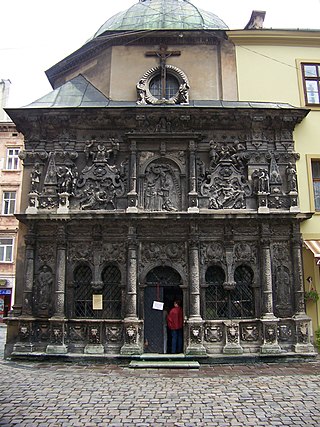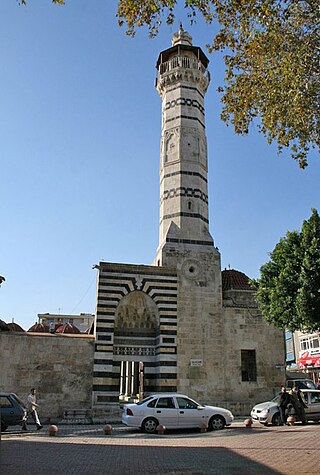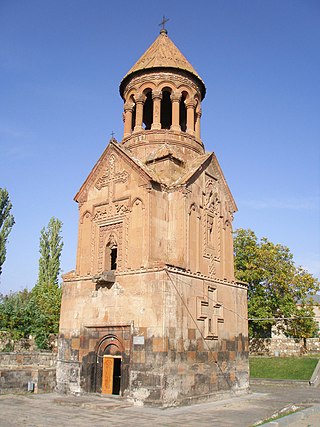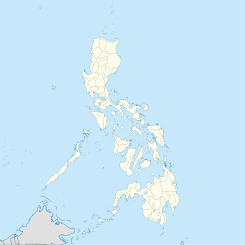
Gergeti Trinity Church is a popular name for Holy Trinity Church near the village of Stepantsminda in Georgia. The church is situated on the right bank of the river Chkheri, at an elevation of 2,170 metres (7,120 ft), under Mount Kazbek.

Buda Castle, formerly also called the Royal Palace and the Royal Castle, is the historical castle and palace complex of the Hungarian kings in Budapest. First completed in 1265, the Baroque palace that occupies most of the site today was built between 1749 and 1769, severely damaged during the Siege of Budapest in World War II, and rebuilt in a simplified Baroque style during the state communist era. Presently, it houses the Hungarian National Gallery, the Budapest Historical Museum, and the National Széchényi Library.

Sant'Ivo alla Sapienza is a Catholic church in Rome. Built in 1642–1660 by the architect Francesco Borromini, the church is widely regarded a masterpiece of Roman Baroque architecture.

Lenyadri, sometimes called Ganesa Lena, Ganesh Pahar Caves, are a series of about 30 rock-cut Buddhist "caves", located about 4.8 kilometres (3.0 mi) north of Junnar in Pune district in the Indian state of Maharashtra. They are cut into a natural cliff or steep slope. Other caves surrounding the city of Junnar are: Manmodi Caves, Shivneri Caves and Tulja Caves. The Lenyadri caves date between the 1st and 3rd century AD and belong to the Hinayana Buddhism tradition. Some have later been adapted to Hindu use.

The Mohatta Palace is a museum located in Karachi, Sindh, Pakistan. Designed by Ahmed Hussain Agha, the palace was built in 1927 in the posh seaside locale of Clifton as the summer home of Shivratan Mohatta, a Hindu Marwari businessman from what is now the modern-day Indian state of Rajasthan. The palace was built in the tradition of stone palaces of Rajasthan, using pink Jodhpur stone in combination with the local yellow stone from nearby Gizri. Mohatta could enjoy this building for only about two decades before the partition of India, after which he left Karachi for the new state of India.

Noravank is a 13th-century Armenian monastery, located 122 km from Yerevan in a narrow gorge made by the Amaghu River, near the town of Yeghegnadzor in Armenia. The gorge is known for its tall, sheer, brick-red cliffs, directly across from the monastery. The monastery is best known for its two-storey Surb Astvatsatsin Church, which grants access to the second floor by way of a narrow stone-made staircase jutting out from the face of building.

Makaravank is a 10th-13th century church complex near the Achajur village of Tavush Province, Armenia, located on the slope of Paitatap Mountain. The complex of Makaravank ranks among Aghtamar, Bgheno-Noravank, Gandzasar with its originality, richness and variety of ornaments and occupies an important place in Armenian architecture.

The Boim Chapel is a monument of religious architecture in Cathedral Square, Lviv, Ukraine. It was constructed from 1609 to 1615 and is part of Lviv's Old Town, a UNESCO World Heritage Site.

The Willam R. Belknap School is a former school building in the Belknap neighborhood of Louisville, Kentucky United States. It was added to the National Register of Historic Places in 1982. It was designated as a local landmark by the Louisville Metro Landmarks Commission in 2001.

The Suntop Homes, also known under the early name of The Ardmore Experiment, were quadruple residences located in Ardmore, Pennsylvania, and based largely upon the 1935 conceptual Broadacre City model of the minimum houses. The design was commissioned by Otto Tod Mallery of the Tod Company in 1938 in an attempt to set a new standard for the entry-level housing market in the United States and to increase single-family dwelling density in the suburbs. In cooperation with Frank Lloyd Wright, the Tod Company secured a patent for the unique design, intending to sell development rights for Suntops across the country.

The Sinan Pasha Mosque is an early Ottoman-era mosque in Damascus, Syria, located along Suq Sinaniyya Street.

The Great Mosque of Adana, also known as the Ramazanoglu Mosque, is a 16th-century mosque in Adana, Turkey. It forms part of a complex (külliye) that includes a madrasah and a mausoleum (türbe). The complex is on Kızılay street, next to the Ramazanoğlu Hall.

Holy Mother of God Church, sometimes known as Yeghvard Church, is a medieval Armenian church located at the center of Yeghvard in the Kotayk Province of Armenia. It was completed in 1301 during the rule of the Zakarid dynasty by the medieval Armenian architect Vardapet Shahik. The main purpose of the construction was to mark the millennium of the spread of Christianity as the state religion in Armenia. It was built and completed as an alternative church of the nearby ruined Katoghike Church, a large three-nave basilica dating back to the 5th and 6th centuries.

The Waterbury Municipal Center Complex, also known as the Cass Gilbert National Register District, is a group of five buildings, including City Hall, on Field and Grand streets in Waterbury, Connecticut, United States. They are large stone and brick structures, all designed by Cass Gilbert in the Georgian Revival and Second Renaissance Revival architectural styles, built during the 1910s. In 1978 they were designated as a historic district and listed on the National Register of Historic Places. They are now contributing properties to the Downtown Waterbury Historic District.

Belgrade Cooperative was a Serbian cooperative bank founded in 1882 to promote savings and support small enterprises, craftspeople and the poor of Belgrade. Member-shareholders have been paying membership in amount of one Serbian Dinar per week. That was the way for cooperative to become a public savings bank. Luka Ćelović was the first president of cooperative, also a first Serbian insurance group.

The funerary complex of Sultan Qaytbay is an architectural complex built by the Mamluk sultan al-Ashraf Qaytbay in Cairo's Northern Cemetery. It was built between 1470 and 1474. The main building is a mosque attached to Qaytbay's mausoleum, while other parts of the complex include residential structures, a drinking trough for animals, and a smaller tomb. The complex is considered one of the most beautiful and accomplished monuments of late Mamluk architecture and it is pictured on the Egyptian one pound note.

Main Range Railway is a heritage-listed railway from the end of Murphys Creek railway station, Murphys Creek to the Ruthven Street overbridge, Harlaxton, Queensland, Australia. It forms part of the Main Line railway and was built from 1865 to 1867 by railway builders Peto, Brassey and Betts. It was added to the Queensland Heritage Register on 5 February 2009.

Shah-e-Alam's Tomb and Mosque, also known as Rasulabad Dargah or Shah Alam no Rozo, is a medieval mosque and tomb complex (Roza) in Shah Alam area of Ahmedabad, India.

İskender Pasha Mosque, a.k.a. Terkim Masjid is a historic mosque located in Fatih district in Istanbul, Turkey.

The Mosque ofAmir Qijmas al-Ishaqi or Abu Hurayba Mosque is a late Mamluk-era mosque in Cairo, Egypt. It dates from 1480-81 CE and is located in the historic al-Darb al-Ahmar district, near Bab Zuweila. It is considered by many to be one of the finest examples of late Mamluk architecture.


































